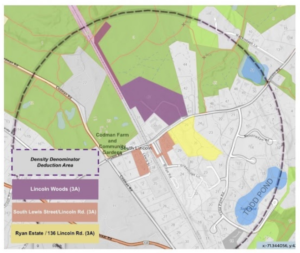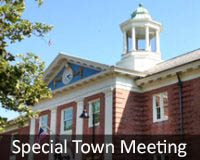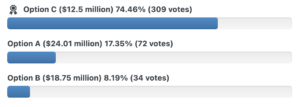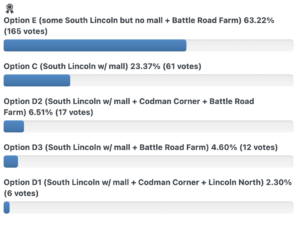The Lincoln Squirrel ran three polls this week to gauge which community center and HCA zoning options residents preferred and if they supported allowing The Commons to build more units. All three issues will be subject to votes at the Special Town Meeting on December 2. The polls, which closed at 8 p.m. on November 29, were open to both Squirrel subscribers and nonsubscribers. With the caveat that the polls were not alt all scientific, here are the results:
Option E is not compliant, HCA consultant says

The Lincoln Residents for Housing Alternatives map of part of Option E for HCA rezoning. Not shown: the Battle Road Farm portion of the subdistrict.
(Editor’s note: the headline to this story was amended on November 30. See this clarification for details.)
Utile, the town’s planning consultant for Housing Choice Act rezoning, said this week that Option E would not pass muster with the state because it does not meet the law’s requirements.
With Utile’s help over the last eight months, the Housing Choice Act Working Group came up with four options for Lincoln to comply (Options C, D1, D2, and D3), all of which include the mall. But Lincoln Residents for Housing Alternatives (LRHA) argued against including the mall and proposed Option E, which they say gives the town more control over the mall’s future by excluding it from HCA rezoning while also minimizing new housing in the village area and its resulting congestion. Option E will join HCAWG’s four on the ballot at Saturday’s Special Town Meeting.
The HCA requires towns including Lincoln to allow 635 units of multifamily housing over at least 42 total acres, which can be broken into portions or subdistricts under certain conditions. One of those conditions, according to the state’s Section 3A guidelines (Chapter 5, Section a, Part ii), is that “no portion of the district that is less than 5 contiguous acres [of] land will count toward the minimum size requirement.”
“In the professional opinion of our consultant, E does not appear to be compliant because the south Lewis Street subdistrict is smaller than 5 acres and is not contiguous with the rest of the Lincoln Road subdistrict,” Select Board member Jennifer Glass wrote in LincolnTalk on the afternoon of Wednesday, Nov. 29. That verbiage is also on the HCAWG website.
Option E straddles the south side of the railroad tracks but does not include the parcels between the track and Lewis Street. Lincoln Road (though no actual parcels of land) connects the two pieces.
Also on Wednesday, HCAWG also posted updated maps and tables for its four options, which are slightly different from previous versions. “There are changes in the unit/acre calculations because our consultant, Utile, worked with the state to refine calculations when there are significant wetlands involved,” the group wrote. “The allowed units/acre will be written into the zoning bylaws and is a maximum, regardless of the size of the units.”
The new slide deck also includes maps showing the likelihood of housing development in each subdistrict based on its current status. Option E has the largest amount acreage of allowed multifamily housing in parts of town other than the village area and thus the lowest amount that is likely to be developed.
LRHA meeting draws more than 170
The LRHA held a heavily attended Zoom meeting (video here) on Wednesday evening to review all five options, make the case for option E, and answer questions, which viewers could post using Zoom’s chat function (though not verbally). The typed questions were visible to the meeting hosts but not the audience, and the hosts acknowledged that they couldn’t get to all of them in the 90-minute session. Utile’s analysis of option E from earlier in the day did not come up.
After the meeting, the LRHA wrote on LincolnTalk that they are “are parceling out the remaining questions to the presenters best equipped to answer them. We’ll post those questions and answers as soon as we can collate them.”
One of the questions that came up again at the session was why the town was putting the HCA options to a vote now when the state deadline for enactment isn’t until December 2024. “If the state sees we’re working in good faith on a solution, I’m sure the roof doesn’t cave in on Jan. 1, 2025,” said Bob Domnitz, a former member of HCAWG and the Planning Board.
Town officials have said they’ll need the extra time in case the March 2024 vote doesn’t result in a bylaw acceptable to the state, which has not given any indication either way about whether it might be flexible about the deadline.
Option E going forward
Utile’s opinion notwithstanding, Option E will still be on the ballot on December 2, and whatever option voters choose that day will also be submitted for a compliance check. However, if they vote for option E and the state rejects that plan after review early next year, it will not be on the warrant in March. In that case, “the working group and the Planning Board would have to go back through a public process again” to fix the problems to bring the option into compliance, Glass said at the November 27 Select Board meeting.
Town officials have already submitted Option C to the state for a compliance check, though they don’t expect a state reply much before the final vote at Town Meeting in March.
Officials have also said that if Option E prevails, the town will offer a separate article at the Annual Town Meeting in March asking voters to rezone the mall to allow a mixed use of commercial and multifamily housing.
Town Administrator Tim Higgins noted at the November 27 Select Board meeting that the commuter lot, even though it’s part of the town’s HCA rezoning, cannot be sold or leased for development without Town Meeting approval because it is town-owned land. He also reiterated that recent executive sessions of the Select Board concerning a piece of property are not about the commuter lot and that “there is no specific proposal in the works that’s currently under negotiation.”
Millicent “Penny” Mitchell, 1940–2023
Millicent Irmiger “Penny” Mitchell, 83, of Lincoln, passed away on November 14, 2023 at the Commons in Lincoln.
Penny was born on February 3, 1940, daughter of the late Donald K. Irmiger, Sr., and Helen Irmiger Murray. She was raised in Green Bay, Wisc. and attended Skidmore College before graduating from Lawrence University, earning a bachelor’s degree in English. She worked in advertising for Jordan Marsh and later became a homemaker and mother.
Penny went on to marry Richard L. Mitchell. Together, they loved to sail and race their boat, ski, and travel. They were also passionate gardeners — they loved to spend hours working in their beautiful gardens. Penny also enjoyed photography and captured their many travels and memories. In between, they cherished time spent with family and their eight grandchildren.
Penny was predeceased by her husband Richard in 1999 and her brother, Donald Irmiger, Jr. She is survived by daughter Amy Lyon, sister Gretchen Morrison and husband Robert, and brother Chadwick Irmiger and wife Kathryn. She is also survived by her stepchildren, Edward Mitchell (Judith), Christie DiPietro (David), Margaret Prevot (Roger), and eight grandchildren, whom she loved dearly and was thrilled to spend time with.
Services will be held privately. Penny will be laid to rest beside her late husband Richard in Waterville Valley, N.H. In lieu of flowers, donations in her memory may be made to the Progeria Research Foundation, PO Box 3453, Peabody, MA 01961-3453.
Arrangements are entrusted to Dee Funeral Home & Cremation Service of Concord. To make an entry in her online guestbook, please click here.
My Turn: Look at all the options for HCA rezoning
By Peter Braun
In the interest of enhancing rational discussion about the proposed rezoning options, I am repeating and elaborating on the gist of a comment I posted a couple of days ago in the Lincoln Squirrel in response to Ruth Ann Hendrickson’s article.
This is not just an Option C vs. Option E debate. The Working Group and Select Board have wisely offered us some potential alternatives, which I view as potential compromise solutions. As a lawyer, I was always interested in potential compromises, so I appreciate their having offered some more choices than just Option C or bust.
Options D-1, D-2, and D-3 all offer the same benefit as Option C in terms of rezoning the mall and rezoning some other parcels in South Lincoln. In fact, they could have been labeled C-1, C-2, and C-3. And they all include large amounts of areas that are understood to be highly unlikely to be developed (Lincoln Woods and Ryan Estate). Those unlikely-to-be-developed areas, as well as the unlikely-to-be-developed areas in North Lincoln included in several options, are, to my mind, just benign puzzle pieces to satisfy the state’s 42-acre requirement.
Rather than be distracted by these benign puzzle pieces, I have tried to focus on where the real action is, in South Lincoln. That’s where the public transit is. That’s where our commercial area is. That’s where we have pointed to for many years as the area for some sort of “walkable village.” That’s where the Working Group has appropriately focused.
In trying to sort out which of these four “C-related” options are preferable, the question for me is how much South Lincoln development besides the mall itself are we willing to enable by right, now and forever. I am totally in favor of by-right rezoning for the mall itself, and I trust their judgment. That will entail a large addition of housing and much-needed revamping of the mall’s commercial and public spaces. How much more by-right development in South Lincoln do we want, and how likely is it to occur?
Jennifer Glass’s excellent presentation materials at this week’s Mothers Out Front meeting very well articulated what our choices are in terms of what areas could be developed in reality, depending on what the property owners and potential developers decide to do. As I understand what was presented, in the case of D-3, our choice is the mall plus the properties across the street (essentially between Ridge Road and the Ryan Estates, going several blocks in from the road), with a maximum collective potential of 262 new housing units. For D-1 or D-2, focusing only on their South Lincoln aspects, it’s the mall plus the properties across the street and the properties within the Lincoln Road/Codman Road/Lewis Street/railroad tracks rectangle, with a maximum collective potential of 383 new units. For Option C, it’s the mall plus the properties across the street, the properties within the aforementioned rectangle, and the properties further along Codman Road down to 117, with a maximum collective potential of 480 new units. The tale of the numbers: 480 vs. 383 vs. 262.
There are many factors that would drive whether and how much of these areas other than the mall (which has its own development trajectory) will actually be redeveloped for multi-family housing. Among these factors are assembling (buying) enough contiguous parcels, septic infrastructure, wetlands, and parking (which, in my mind, could realistically necessitate designing for one or possibly two cars per housing unit). As others have mentioned, all of these factors and their cost would be balanced by potential developers against the multiple other opportunities that are sure to arise in other communities as the impact of the HCA takes hold. In the meantime, in the absence of an effective crystal ball, all we have to go on are the maximum developable units articulated by Jennifer.
My personal opinion is that D-3 offers us a big chunk of what many want — redevelop the mall and open the door to nearby by-right multi-family housing (across the street) — and offers what some, like me, may want, which is a chance to see what happens if as many as 262 new housing units and the inevitable car-usage are added to that area, before we enable even more within the aforementioned rectangle and along Codman. Others may have a different risk tolerances and/or may anticipate that the amount of development enabled by Option C or one of the other Ds will be significantly less than the maximums.
Reasonable people can debate the merits of all options. But, again, we do have multiple options. My two cents, in hopes of stimulating rational dialogue.
“My Turn” is a forum for readers to offer their letters to the editor or views on any subject of interest to other Lincolnites. Submissions must be signed with the writer’s name and street address and sent via email to lincolnsquirrelnews@gmail.com. Items will be edited for punctuation, spelling, style, etc., and will be published at the discretion of the editor. Submissions containing personal attacks, errors of fact, or other inappropriate material will not be published.
Correction
 In the November 22 article headlined “Panel adds fifth rezoning option after pressure from citizen group,” a quote was misattributed. It was David Cuetos, not Ben Shiller, who said, “We’re trying to avoid actively talking about the spirit of the law, because it has no real meaning when you think about it profoundly.” Cuetos then added, “Every one of us has a different interpretation of what the spirit of the law is.” The story has been updated.
In the November 22 article headlined “Panel adds fifth rezoning option after pressure from citizen group,” a quote was misattributed. It was David Cuetos, not Ben Shiller, who said, “We’re trying to avoid actively talking about the spirit of the law, because it has no real meaning when you think about it profoundly.” Cuetos then added, “Every one of us has a different interpretation of what the spirit of the law is.” The story has been updated.
My Turn: In support of Option C
By Ken Hurd
At one of the recent forums hosted by the HCAWG (Housing Choice Act Working Group), one particularly insightful resident posed a poignant question to the proponents of an alternative Option E. She asked, “What is it you stand for?”
Although there was no immediate response, we now know the answer, according to the mailing most residents recently received about a meeting planned by proponents of Option E. You can find it on the back of the flyer under the label “Our Guiding Principles,” and I would like to highlight what I see as some inconsistencies.
Create more affordable housing
Many proponents of an alternative Option E express concern that the HCA limits the percentage of affordable housing to 10%. Because Lincoln normally requires 15% affordable units in any multi-family development, the delta of their concern is 5%. In Lincoln’s case, the HCA requires zoning that will allow 635 units, and 5% of that would be 32 units. As a reminder, the HCAWG responded early on to the residents of the Ridge Court Condominium property, a.k.a. the “flying nun” apartments. Despite the fact that this property is one of the most logical to include in the rezoning, they asked to be excluded in order to preserve the 36 units of relatively affordable apartments that already exist. The HCAWG agreed, and the delta of this exclusion represents more than the 5% about which the alternative proponents are so concerned.
Protect commercial retail in our village center
To anyone who has paid any attention to the state of retail services in Lincoln Station over the last ten years, they might have noticed a decline or turnover in establishments and an increase in vacancies. This is occurring not just at the mall but in the entire Lincoln Station area. As noted in the 2010 Comprehensive Long Range Plan, “the town needs to be receptive to more housing near the train station,” and as was predicted in 2010, “small businesses currently operating around the train station may find it very difficult to survive in the future unless the area includes more housing and, ironically, more businesses.” Absent more housing, existing retail will most likely continue to wither away.
Safeguard Lincoln’s wetlands protection bylaw
As noted multiple times by the HCAWG, all underlying regulations required by the bylaws of Lincoln will continue in effect, and that includes all wetland protections currently in place.
Focus on locations with existing infrastructure while minimizing the need for greenfield construction
If this means rezoning Battle Road Farm, it would appear that this is no more than a tactic to subvert the intent of the Housing Choice Act since condominium regulations make it nearly impossible to create new housing in that location.
Preserve historically significant properties
A worthy goal, but with the few significant properties that exist in the Lincoln Station area, this could most likely be accommodated by any of the options with a minor adjustment.
Honor the legacy of past generations’s work to create a variety of housing choices and multi-family housing
Most Lincolnites, particularly those who know the town’s history, will agree with this statement. Time and again, previous generations have stepped up to do more than Lincoln’s fair share in preserving open space while also increasing our housing stock to accommodate a variety of needs. In my opinion, it would be a slap in their ancestral faces to shirk our responsibility to the region by raising the drawbridge and rezoning for the least amount of new housing possible while claiming compliance.
Save our key in-town parcels from HCA’s 90% market-rate zoning mandate, allowing funds from Lincoln’s limited Affordable Housing Trust to be more wisely spent for much-needed low- and moderate-income housing units in Lincoln
To me, there is no correlation between saving in-town parcels and using AHT funds for needed housing. This “principle” advocates for nothing more than kicking the can down the road toward inaction.
Finally, I think we can all agree that the Housing Choice Act is forcing our hand no less than in many of the surrounding communities. I hope that we can rise to meet this challenge as past Lincoln residents have done so many times before. There is no question in my mind that we can be as creative as our forbears and find solutions that will maintain the town’s character that we all cherish. I sincerely believe that this will be best achieved by voting for Option C.
So please, join me in supporting Option C as the best way to revive the Lincoln Station area as well as to meet our responsibility to the region by creating more actual housing consistent with our town vision statement, namely:
“Fostering economic, racial, ethnic, and age diversity among its citizenry through its educational, housing and other public policy.”
“My Turn” is a forum for readers to offer their letters to the editor or views on any subject of interest to other Lincolnites. Submissions must be signed with the writer’s name and street address and sent via email to lincolnsquirrelnews@gmail.com. Items will be edited for punctuation, spelling, style, etc., and will be published at the discretion of the editor. Submissions containing personal attacks, errors of fact, or other inappropriate material will not be published.
What you need to know for Saturday’s Special Town Meeting
 The following is based on information provided by town officials.
The following is based on information provided by town officials.
Saturday’s Special Town Meeting is fast approaching, and we want to make sure you know where to turn for information. Here is a brief guide with links to further information:
Meeting logistics
- Please visit our Special Town Meeting web page for up-to-date information.
- Town Meeting begins at 9:30 a.m. sharp! Voter check-in begins at 8:30.
- Also on the web page are links to the warrant and voting instructions.
- We are accommodating to all! We have reserved parking closest to the entrance for handicap and mobility-impaired residents. We also provide the option for fully interactive participation and socially distanced seating in the Reed Field House.
- We have provided maps of where to park, where to enter, and a picture showing the Auditorium/Lecture Hall setup.
- Child care is being provided for kids age 5+ by LEAP (the Lincoln Extended-Day Activity Program) from 8:30 a.m. until the meeting ends. Snacks and a pizza lunch will be provided. Please click here to sign up in advance. Each child must be registered separately. The cost is $40 per child, payable by check when you arrive at LEAP.
Articles 1 & 2 — Community Center
- The Community Center Building Committee has developed three concepts for consideration. The goal of the meeting is to determine which concept has majority support from those voting at the meeting.
- That concept will advance to the Schematic Design Phase in preparation for the two (2) votes needed to secure funding:
- Saturday, March 23, 2024 — Annual Town Meeting: a two-thirds majority vote needed to fund the project, AND
- Monday, March 25, 2024 — Ballot Vote: A simple majority vote is needed to fund the project.
- Learn about the concepts on the Community Center Building Committee website.
- You can view the Finance Committee’s Capital Capacity Presentation here.
Article 3 — The Commons Expansion
- New England Life Plan Communities, owner of The Commons in Lincoln, is proposing to build an additional 28 units. Background materials can be found here.
- This vote requires a two-thirds majority for approval.
Article 4 — Housing Choice Act Working Group
- Residents will consider five Zoning District Options for compliance with the Housing Choice Act (four developed by the Housing Choice Act Working Group and one suggested by a group of residents).
- The goal of the meeting is to determine which option has at least majority support from those voting at the meeting.
- That option will go through an initial compliance check by the state Executive Office of Housing & Livable Communities in preparation for a vote at the March 23, 2024 Annual Town Meeting. A simple majority vote at that March Town Meeting will be required to approve the new zoning bylaws.
- Learn more about the options on the Housing Choice Act Working Group web page.
My Turn: Reject Option E if you support fairness in Lincoln
By Jonathan Soo
All Lincoln residents should feel threatened by how Option E supporters changed the rules so that they could force a plan developed in secret by an unaccountable private group onto the December 2 Town Meeting ballot and making what should have been an unofficial survey into a binding vote* for the plan that will be presented at the March 2024 Town Meeting.
In 2022, after the MBTA Communities Act was signed into law, the town created a detailed plan describing how it would develop a zoning bylaw. The town committed to having a town working group create a new zoning bylaw, followed by public hearings leading up to the March 2024 Town Meeting.
The town’s Housing Choice Act Working Group (HCAWG) collectively spent hundreds of hours evaluating and developing a number of options, gathering feedback from affected residents in a series of information sessions, and carefully ensuring that the proposed options meet not only the state’s requirements but also federal Fair Housing Act requirements, Lincoln’s Comprehensive Long Range Plan, and other obligations.
This fall, a small group of people opposed to additional housing in the town center decided that rather than making their case in March, they would hijack the process by developing their own plan using every loophole available to make sure no new housing could be built there. This plan was developed in secret by a small group of self-selected insiders, with no minutes or records of who participated or even when meetings were held.
On November 14, the Select Board voted to change the rules of the game. It asked HCAWG to rubber-stamp Option E so that it could be added to the ballot without review, and announced that the informal survey at the December 2 Town Meeting would be changed into a binding vote to select the option to be placed on the March ballot, effectively adding a primary vote to the process with two weeks’ notice — with one of those two weeks being the Thanksgiving holiday.
Even if Option E was developed in a legitimate way, changing the December 2 vote from a survey to a binding vote is an incredibly unfair change to the process. It is simply not possible for town residents to digest and evaluate all of the options in just a few days, especially since one of the options has only been publicly known for a single week. Too many residents will be entering the meeting with no real understanding of the implications of voting for each choice, to be swayed by a few minutes of rhetoric before the vote.
On top of this, many residents will be unable to rearrange their schedules at short notice to attend the meeting, assuming they hear about the changes at all. Most residents interested in the process still have a postcard on their refrigerators describing the December 2 meeting as “‘Sense of the Town’ from residents via an informal paper ballot on preferred option – C or D.”
Of course, Option E was not developed in a legitimate way — not in any way that should be acceptable for the town to place on a binding ballot. By placing it on the ballot and stating that it is a viable choice for the March 3 vote, the Selects are saying that the town stands behind it morally, ethically, and legally. No zoning law developed in secret should be allowed on any town ballot.
Every Lincoln resident, no matter which of the town’s options they support (C, D1, D2, or D3), should go to Town Meeting and vote against Option E as long as it has not been rejected.
* Editor’s note: Although the vote is binding, changes may still be made to bring the measure into compliance with state law if necessary — see the HCAWG website (Q&A #4 under “2023 11 22 FAQs).”
“My Turn” is a forum for readers to offer their letters to the editor or views on any subject of interest to other Lincolnites. Submissions must be signed with the writer’s name and street address and sent via email to lincolnsquirrelnews@gmail.com. Items will be edited for punctuation, spelling, style, etc., and will be published at the discretion of the editor. Submissions containing personal attacks, errors of fact, or other inappropriate material will not be published.
My Turn: How about equity for seniors?
By David Levington
The interminable meetings of the CCBC (Community Center Building Committee) have been disheartening. I had expected discussions of how to design a vibrant new center for the town’s seniors, but instead all I heard was talk about how to save money.
Residents seem preoccupied with the $93 million spent on our new schools and don’t want to add to our tax bills. They seem to forget that we are just continuing a process that began in 2010, when a study group concluded that Bemis Hall and the Hartwell Pods were inefficient. Thirteen years later after several interim reports, they are still questioning the need for something new, and decision time for a community center is here.
The warrant for the December 2 Special Town Meeting asks us to choose between three community center options. The option we choose will be further developed and put forward for final approval at the March 2024 Town Meeting and a ballot-box funding vote. If all that goes through, we should have a new community center in a few years.
But which option?
One of the options is totally unacceptable; its only benefit is that it saves money. It calls for the renovation of one of the old pods, and has LEAP (the after-school program for kids) remain in another unimproved pod.
The other two options each provide for a new community center and a facility for LEAP. The 100% option, expected to cost $24 million, offers a new building on one level with enough space for both LEAP and a gracious community center. The 75% option costs $19 million, leaves LEAP in a renovated pod, and provides “just enough” space for the Council on Aging & Human Services to continue its present programs.
Is that what we want, after a dozen years of planning? A new building (nice of course) but everything crammed into smaller spaces? The financial difference between the two options is about $5 million, which equates to about $150 per year difference in the property tax on an average home (under $100/year on a condo).
Our decision will determine what we will live with and experience for the next 20 years. I urge you to vote for the more generous plan. We seniors have always supported our schools and programs for children. We should do the equitable thing and give our seniors a beautiful new gathering place.
“My Turn” is a forum for readers to offer their letters to the editor or views on any subject of interest to other Lincolnites. Submissions must be signed with the writer’s name and street address and sent via email to lincolnsquirrelnews@gmail.com. Items will be edited for punctuation, spelling, style, etc., and will be published at the discretion of the editor. Submissions containing personal attacks, errors of fact, or other inappropriate material will not be published.
My Turn: The tax impact of Option 1 for the community center
By Lynne Smith
On December 2, many of us will go to the Donaldson Auditorium in our new school to vote on the options for a community center. The newsletter sent by the Selects last week estimated the tax impact of three building options.
Here I will focus on Option 1, the 100% option that will cost $24.01 million. For households with a median tax bill of $17,488, this option will increase annual taxes by about $773.* The new school, which cost approximately $93 million, resulted in an annual tax increase of $2,100.**
These are big numbers, especially when you do the math: the bonded debt for the school over 30 years adds up to about $63,000 for each household.
When you do the math for Option 1 for the community center, the bonded debt over 30 years is about $23,190 for each household.
Everyone who attends the meeting can decide on the value of a new community center building for their household. I have not yet decided how I will vote but I am thinking seriously about the decisions our generation of Lincoln residents is making. Brand-new buildings will saddle us with large tax bills for years to come. And our irreplaceable historic buildings require our stewardship for their continued use.
As a recent New York Times article said about Town Meetings, “The most important part of these meetings is always the ensemble of townspeople who stand at the small podium to ask, sometimes beg, that our needs be met, wrongs be prevented or righted.” That’s a lot to ask of a municipal meeting — but let us have the courage to do so.
I look forward to meeting again in the auditorium and seeing my friends, neighbors, committee members and town staff as we gather to participate in democratic governance on December 2!
* If the entire cost were paid through bonding at an interest rate of 4–4.5%.
** See note on page 6 in the FinCom’s “Town Capital Capacity” presentation in September 2023.
“My Turn” is a forum for readers to offer their letters to the editor or views on any subject of interest to other Lincolnites. Submissions must be signed with the writer’s name and street address and sent via email to lincolnsquirrelnews@gmail.com. Items will be edited for punctuation, spelling, style, etc., and will be published at the discretion of the editor. Submissions containing personal attacks, errors of fact, or other inappropriate material will not be published.




